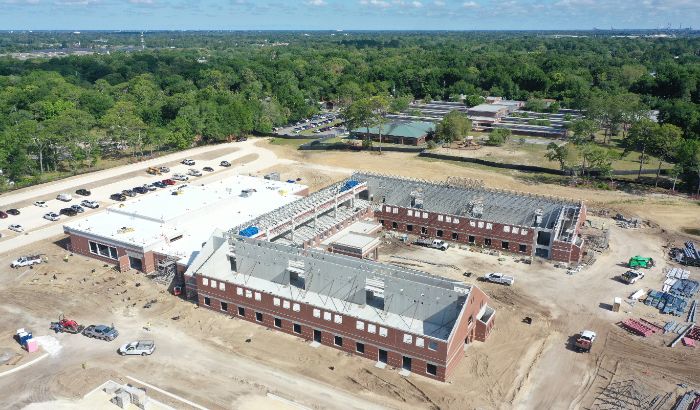April 30, 2024 – The Duval County School Board recently heard a consultant’s proposal to re-draw school boundaries, align feeder patterns, and consolidate many small or under enrolled schools.
The district will soon host public meetings and provide other opportunities for members of the community to share their feedback and ideas on the proposal.
That proposal has inspired many questions, which are addressed below.
Why are new boundaries, school consolidations, and closures being considered?
The district requested the proposal for three major reasons.
Reason One: Operational Revenue and Falling Enrollment
School funding in Florida districts is directly tied to enrollment. The more students a district has, the more funding it receives.
Ever since the emergence of school choice and charter schools, district enrollment has declined. Each time a student leaves a district school, that student’s funding follows the student to their new school.
In 2009, fewer than 2,000 students attended charter schools in Duval County. Today, funded enrollment for the 43 charter schools that have opened in our county is more than 25,000 students.
In addition to charter school students, the state now provides funding for students to choose private schools. In just five years, the number of students taking private school scholarships has grown from less than 4,000 to more than 12,000, with many of these students being previously enrolled and funded in traditional schools.
Because funding is tied to enrollment, the impact of lost enrollment is lost funding, and in recent years, the district has been unable to cover its expenses with the revenue available.
Just like a household, when expenditures exceed revenue, one must dip into savings to pay the bills. Over the last four years, the district has had to use $31.8 million in reserves (savings) to meet its current expenses. The district expects to use an additional $1 million of reserves in the current year.
State law requires the district to maintain a minimum level of reserves. The district is near that minimum level and can no longer rely on reserves to meet annual expenditures.
Reason Two: A $1.4 Billion Gap in Master Facility Plan projections
The school board approved the district’s master facility plan in 2019, prior to the pandemic. Voters approved a half-penny sales tax as the primary funding for the plan in 2020. The plan was based on forecasted revenue from the sales tax and construction cost forecasts prior to the pandemic.
Pandemic-related inflation and new state laws requiring revenue to be shared with charter schools have had major impacts on those forecasts. Revised forecasts incorporating those new factors predict a $1.4 billion gap in the funding available to the district. The district shared details on this situation with the community in December 2023.
Reason Three: Enhancing Boundary Zones
Even though Duval is a choice district, all students must be zoned for a neighborhood school. Those school boundary lines have evolved over the years as neighborhoods have changed, schools have converted to magnets, and new schools have opened.
Currently, students in one elementary school may be zoned for different middle schools and different high schools. Some zones are not contiguous. In many cases, the zones make no sense when considering the proximity of the home to the school and the ability for schools to partner on the continuity of programs and instruction from kindergarten through high school.
Because of the financial situation related directly to the master facility plan and the operating budget challenges the district is facing, it was necessary to revisit the plan and consider additional cost saving measures. Since the district needed to address the financial factors of the plan, it gave the district an opportunity to consider better, more meaningful neighborhood school boundaries.
How does consolidating and closing schools help?
Every school requires funding for fixed administrative costs just to open their doors, regardless of how many students are in the building. These costs include things like school administration, front office staff, custodial staff, cafeteria staff, and facility maintenance costs. Depending on the school, these costs are typically between $750,000 and $1.5 million per school.
Because of declining enrollment, many schools are operating far below capacity. By combining those schools, the district can save the basic operating costs of the school that is closed, and that leaves more funding that can go into student learning and support activities.
What did the consultant consider in their recommendations?
In the face of declining enrollment and the termination of federal financial support from the pandemic, the consultant was asked to build an initial plan that addressed the following:
- Savings in operation and capital costs
- Optimizing facility usage by minimizing empty student stations
- Reducing major maintenance backlog
- Improving boundaries to create stronger school communities and opportunities for educational innovation and improvement within feeder patterns.
The consultant was not asked to consider other variables such as past school performance, potential impacts on student success, or distribution of programs such as exceptional student education, English language education, and career and technical education. The district and the board will consider these and other variables in arriving at final recommendations.
What schools were recommended for closure in the consultant’s presentation on March 11
The list below is organized by high school feeder pattern. It lists the schools that were proposed for closure by the consultant. It does not list schools that were scheduled for closure in the original Master Facility Plan.
Ed White HS feeder pattern: Hidden Oaks ES and Westside HS
Englewood HS feeder pattern: Kings Trail ES and Windy Hill ES
First Coast HS feeder pattern: San Mateo ES
Fletcher feeder pattern: Anchor ES, Atlantic Beach ES, Mayport ES, and San Pablo ES
(San Pablo ES recommended to merge into a new Seabreeze ES built on the San Pablo site.)
Raines HS feeder pattern: Biltmore ES, George W. Carver ES, Pinedale ES, and Thomas Jefferson ES
Ribault HS feeder pattern: Long Branch ES
Riverside HS feeder pattern: Bayview ES, Fishweir ES, Hyde Grove ES, John Stockton ES, Ortega ES, and West Riverside ES
Terry Parker HS feeder pattern: Arlington ES, Brookview ES, Fort Caroline ES, GRASP Academy, Holiday Hill ES, Lake Lucina ES, Lone Star ES, and Parkwood Heights ES
Dedicated magnet programs/schools:
- A. Phillip Randolph – close program
- GRASP Academy – consolidate into Don Brewer ES
- Joseph Stilwell – close program
- R.V. Daniels – consolidate into R.L. Brown
- YWLA/YMLA – close program
How do larger schools help?
A larger school has more students, and a portion of the revenue allocation for each student covers the fixed, administrative cost of the school. With more students, the share of that fixed cost is smaller, and a larger portion of the revenue can go to help keep class sizes small and support other teaching and learning activities.
In many cases, small schools don’t have enough students to generate the revenue needed to operate the school. That means funding received from larger schools must be redistributed to meet the costs of small schools. It is more cost effective if each school has enough capacity and enough enrolled students to generate the funding to cover its own costs. Many of Duval’s schools are too small to do that.
Why don’t you just close the charters?
Closing charters is not an option available to the district or the school board.
Why do you continue to approve charter schools?
Under Florida law, charters that meet minimum requirements can open and remain open. Under state law, the district cannot control where a charter school can open. If the charter operator meets the requirements of the state contract, the board must approve the charter. The charter school’s contract must be renewed if the school meets academic and financial requirements and is not in material violation of law.
Are any schools being planned for closure for the upcoming school year, 2024-25?
None of the consultant’s recommendations are being considered for implementation in 2024-25. The only schools planned for consolidation and closure next year are Pine Estates Elementary and Charger Academy Middle School, which were approved in the original 2019 Master Facilities Plan, with all of these students moving to new or recently renovated school facilities.
Has the district closed other schools in recent years?
Yes. As outlined in the original Master Facilities Plan, Martin Luther King, Jr. and Henry F. Kite elementary schools were merged into the new Rutledge Pearson Elementary School this year.
Next year (2024-25), Pine Estates Elementary will close and merge into a new school on the current campus of Highlands Elementary. Charger Academy Middle School will also close next year with its students going to either the new Chaffee Trail Middle School or Westside Middle School. These closures are also part of the original Master Facilities Plan.
In recent years, Brentwood Elementary School was closed and merged into North Shore Elementary School. Saint Clair Evans and Carter G. Woodson elementary schools were closed and merged into Northwestern Legends.
The school board recently approved for R.V. Daniels to close and merge into R.L. Brown for the 2025-26 school year.
What is going on with the projects in the original facilities plan?
Construction is already underway at several schools, and those projects will continue. These include:
- Highlands Estates Elementary new school (opening for the 2024-25 school year)
- Chaffee Trail Middle new school (opening for the 2024-25 school year)
- Southside Estates Elementary new school (opening for the 2025-26 school year, one year late due to a construction delay)
- Ribault High new school (opening for the 2025-26 school year)
- Mandarin High School (addition)
- Fletcher High School (addition)
- North Shore Elementary School (deferred maintenance school)
- R.L. Brown Elementary School (renovation)
- Westside Middle School (renovation)
Other projects that were in early phases of planning have been postponed until the district and the school board finalize a new long-term plan that addresses the new enrollment and financial trends impacting public schools. The projects on pause include:
New schools:
- Englewood Elementary School
- Spring Park Elementary School
- Pickett Elementary School
- Louis S. Sheffield Elementary School
- Seabreeze Elementary School
- S.P. Livingston Elementary School
- Venetia Elementary School
Deferred maintenance, major renovations, or additions:
- Biltmore Elementary School
- Fort Caroline Elementary School
- Long Branch Elementary School
- Loretto Elementary School
- Conversion of Charger Academy to an elementary school
- Conversion of Windy Hill Elementary to an exceptional student education center
Additionally, safety and security upgrades have taken place in all schools and are ongoing.
Will there be opportunities for the community to be involved in this plan?
Yes. The district is working with the school board on a program to inform the community of proposed changes and to provide the community with multiple ways to provide feedback. This engagement process is expected to begin in May and continue through the summer.








